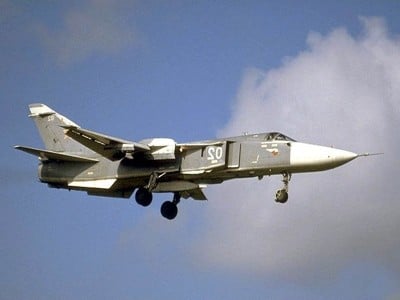Russia’s Air Campaign in Syria Has Changed the Course of History

There are two major unknown questions concerning the breakdown in relations between Turkey and Russia following the ambush of a Russian Su-24 bomber in the skies above Syria. The first is what turn of events prompted Turkey’s leadership to adopt a course of confrontation against Russia. The second is why this escalation did not come months sooner, when Hmeimim was far more vulnerable to Turkish attack or blockade.
When the Russian aircraft first arrived at Hmeimim, the war was going badly for the Syrian government. The terrorists were able to make major advances during the prior months, and were close to threatening Damascus itself. Syrian forces were demoralized by their setbacks and suffering from shortages of equipment and ammunition.
The Russian air group at that point numbered slightly more than 30 aircraft, the base had no long-range air defenses, and only a small ground contingent to protect it on the ground. The bulk of the materiel for the base and for the rearmament of the Syrian army was only beginning to arrive by Syria Express ships which were busy traversing the Bosphorus in both directions.
The Russian military has not yet demonstrated its combat effectiveness or its long reach – it would do only after the air campaign reached its full tempo and began to be accompanied by cruise missile strikes and heavy bomber sorties. If Erdogan decided to launch a ground operation in Syria in September or October of 2015, when the situation presented far more tempting opportunities, Turkish forces stood a far better chance of influencing the outcome of the war in Syria than they do right now.
Several months later, the situation has changed to such an extent that Turkish intervention has almost no chance of scoring a military success. Hmeimim now hosts over 50 aircraft, including Su-27SM, Su-30SM, and Su-35S fighters which can provide effective fighter defense against Turkish incursions. It is also protected by a multi-layered air defense system which includes the S-400 high altitude, long-range missile system, Buk-M2 medium range weapons, and Pantsir-S short-range gun/missile vehicles which are capable of shooting down not only aircraft but also cruise missiles and guided bombs. Hostile aircraft would also face a barrage of electronic countermeasures that would significantly degrade their ability to target Hmeimim. The cruise missile launches by Russian naval ships and heavy bombers have demonstrated the ability to target Turkish air bases and destroy Turkish aircraft on the ground, in the event of escalation of the fighting.
Russian bases in Syria also enjoy the protection from a constant presence of a naval task force, which includes a missile cruiser armed with long-range anti-ship and anti-aircraft weapons, several anti-submarine ships, and at least one missile corvette.
On the ground, the battalion force of Russian troops is hardly the only ground protection of the Hmeimim base. Russian military assistance, including provision of heavy equipment, munitions, and military planners and advisers, has returned the Syrian Arab Army to an effective fighting condition. In addition, the Syrian army is no longer the only military force defending Syria. Thanks to Russian diplomatic efforts, several Syrian opposition groups have joined the government forces in their struggle against the extremists. Likewise the Kurdish units which in the past waged their own uncoordinated struggle against ISIS have now been fully incorporated into the Russian-led coalition in return for Syrian government’s political concessions. There is also a sizable Hezbollah and Iranian presence in Syria. Considering that none of these forces are likely to defect to Turkey in the event of Turkish invasion, and that in some cases they view Turkey as their mortal enemy, the Turkish military would likely not advance very far before suffering heavy losses at the hands of Syria’s defenders. Russian and Syrian long-range weapons now include heavy multiple rocket launchers and Tochka short-range ballistic missiles that would be deadly to Turkish armored columns advancing through narrow mountain paths under the watchful eyes of Russian drones and long-range surveillance aircraft like the Tu-214 and the Il-20.
Even the prospect of the Bosphorus blockade is not as threatening as it once seemed. Syria Express is now mainly concerned with providing consumables like munitions and spare parts to the forces fighting in Syria. In the event Bosphorus were to be blocked, these supplies could be shipped from the Baltic Sea and, in really urgent cases, by air using the traditional Caspian-Iran-Iraq-Syria air route.
In the longer term, it is essential that Russian and Syrian forces punch a corridor through ISIS territory and link up with Iraqi forces, and there are indications that once extremists around Aleppo are neutralized, the nextmajor offensive will be launched in the direction of Raqqa. Doing so would not only break the back of ISIS, but also enable the opening of another overland supply route through the Caspian Sea and Iran. The strength of the Russia-led coalition which seems to have taken all outside observers by surprise is such that it is probably sufficient to deter Turkish military air or ground assault against Syria. While we do not yet know how this happened, it would appear that Moscow was able to outmaneuver Ankara by placing a highly effective military force right under its nose in Syria and reverse the course of the war before Ankara was able to react.
If you’re able, and if you like our content and approach, please support the project. Our work wouldn’t be possible without your help: PayPal: [email protected] or via: http://southfront.org/donate/ or via:https://www.patreon.com/southfront
Subscribe our channel!: https://www.youtube.com/channel/UCaV1…
Visit us: http://southfront.org/
Follow us on Social Media:
http://google.com/+SouthfrontOrgNews
https://www.facebook.com/SouthFrontENTwo
https://twitter.com/southfronteng
Our Infopartners:
http://www.globalresearch.ca/
http://thesaker.is
http://www.sott.net/
http://in4s.net

